MITSUBISHI iMiEV 2016 1.G Owners Manual
Manufacturer: MITSUBISHI, Model Year: 2016, Model line: iMiEV, Model: MITSUBISHI iMiEV 2016 1.GPages: 296, PDF Size: 7.79 MB
Page 241 of 296
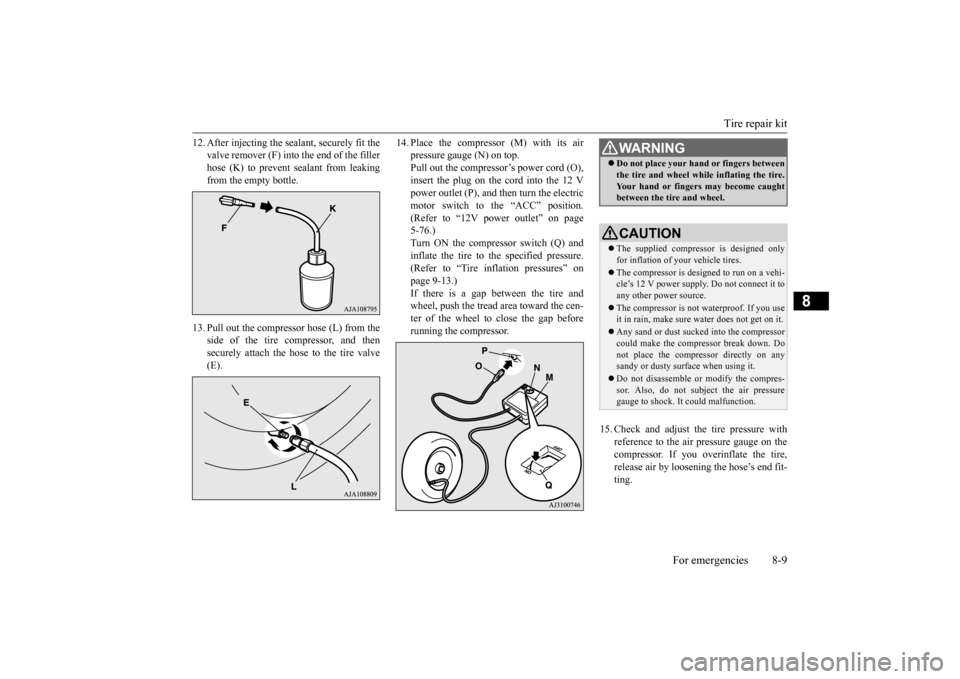
Tire repair kit
For emergencies 8-9
8
12. After injecting the sealant, securely fit the
valve remover (F) into
the end of the filler
hose (K) to prevent sealant from leaking from the empty bottle.
13. Pull out the compressor hose (L) from the
side of the tire compressor, and thensecurely attach the hose to the tire valve (E).
14. Place the compressor (M) with its air
pressure gauge (N) on top.Pull out the compressor’s power cord (O), insert the plug on the cord into the 12 V power outlet (P), and then turn the electricmotor switch to the “ACC” position. (Refer to “12V power outlet” on page 5-76.)Turn ON the compressor switch (Q) and inflate the tire to the specified pressure. (Refer to “Tire inflation pressures” on page 9-13.) If there is a gap between the tire andwheel, push the tread area toward the cen- ter of the wheel to close the gap before running the compressor.
15. Check and adjust the tire pressure with
reference to the air pressure gauge on the compressor. If you overinflate the tire,release air by loosening the hose’s end fit- ting.WA R N I N G Do not place your hand or fingers between the tire and wheel while inflating the tire.Your hand or fingers may become caughtbetween the tire and wheel.CAUTION The supplied compressor is designed only for inflation of
your vehicle tires.
The compressor is designed to run on a vehi- cle’s 12 V power supply.
Do not connect it to
any other power source. The compressor is not waterproof. If you use it in rain, make sure wa
ter does not get on it.
Any sand or dust sucked into the compressor could make the compressor break down. Donot place the compressor directly on any sandy or dusty surface when using it. Do not disassemble or modify the compres- sor. Also, do not subject the air pressure gauge to shock. It
could malfunction.
BK0220401US.book 9 ページ 2015年6月3日 水曜日 午前7時42分
Page 242 of 296
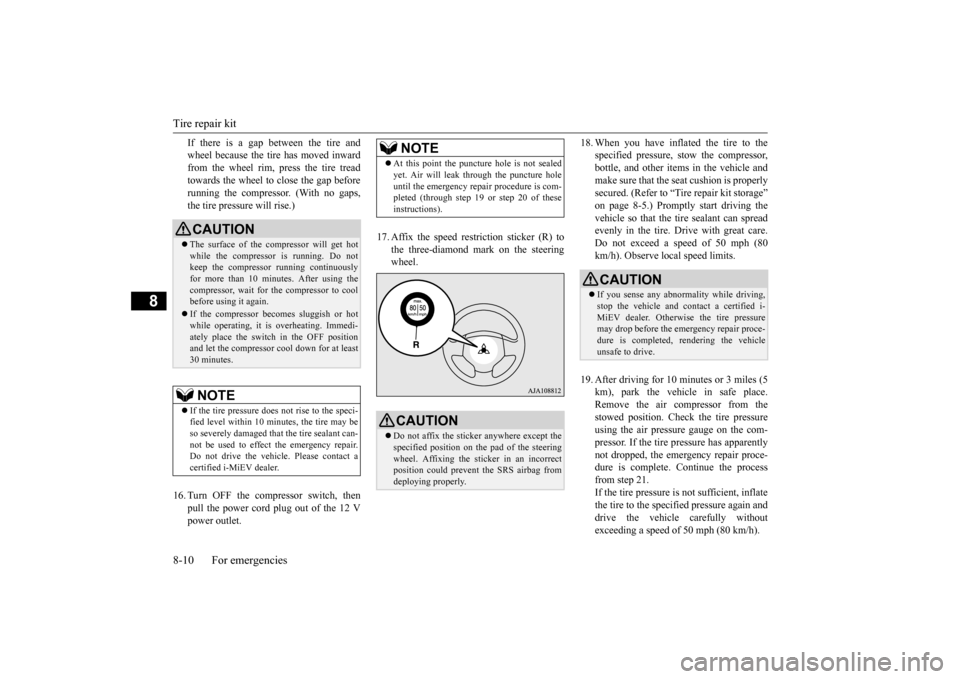
Tire repair kit 8-10 For emergencies
8
If there is a gap between the tire and wheel because the tire has moved inwardfrom the wheel rim, press the tire tread towards the wheel to close the gap before running the compressor. (With no gaps,the tire pressure will rise.) pull the power cord plug out of the 12 V power outlet.
17. Affix the speed restriction sticker (R) to
the three-diamond mark on the steering wheel.
18. When you have inflated the tire to the
specified pressure, stow the compressor,bottle, and other items
in the vehicle and
make sure that the seat cushion is properly secured. (Refer to “Tire repair kit storage” vehicle so that the tire sealant can spread evenly in the tire. Drive with great care.Do not exceed a speed of 50 mph (80 km/h). Observe local speed limits.
19. After driving for 10 minutes or 3 miles (5
km), park the vehi
cle in safe place.
Remove the air compressor from the stowed position. Check the tire pressure using the air pressure gauge on the com-pressor. If the tire pressure has apparently not dropped, the emergency repair proce- dure is complete. Continue the processfrom step 21. If the tire pressure is
not sufficient, inflate
the tire to the specified pressure again anddrive the vehicle carefully without exceeding a speed of 50 mph (80 km/h).
CAUTION The surface of the compressor will get hot while the compressor is running. Do not keep the compressor running continuously for more than 10 minutes. After using thecompressor, wait for the compressor to cool before using it again. If the compressor becomes sluggish or hot while operating, it is
overheating. Immedi-
ately place the switch in the OFF positionand let the compressor cool down for at least 30 minutes.NOTE
If the tire pressure does not rise to the speci- fied level within 10 mi
nutes, the tire may be
so severely damaged that the tire sealant can- not be used to effect the emergency repair. Do not drive the vehicl
e. Please contact a
certified i-MiEV dealer.
NOTE
At this point the punctu
re hole is
not sealed
yet. Air will leak through the puncture holeuntil the emergency repa
ir procedure is com-
pleted (through step 19 or step 20 of these instructions).CAUTION Do not affix the sticke
r anywhere except the
specified position on th
e pad of the steering
wheel. Affixing the sticker in an incorrect position could prevent the SRS airbag fromdeploying properly.
CAUTION If you sense any abnorma
lity while driving,
stop the vehicle and c
ontact a certified i-
MiEV dealer. Otherwise the tire pressure may drop before the emergency repair proce- dure is completed,
rendering the vehicle
unsafe to drive.
BK0220401US.book 10 ページ 2015年6月3日 水曜日 午前7時42分
Page 243 of 296
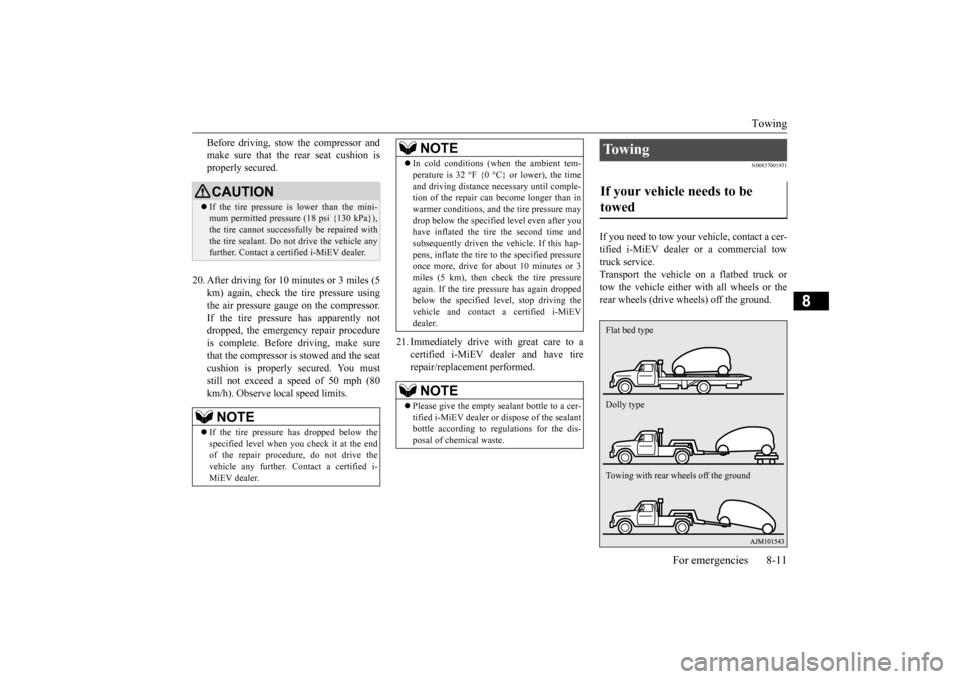
Towing
For emergencies 8-11
8
Before driving, stow the compressor and make sure that the rear seat cushion isproperly secured.
20. After driving for 10 minutes or 3 miles (5
km) again, check the tire pressure usingthe air pressure gauge on the compressor. If the tire pressure has apparently not dropped, the emergency repair procedureis complete. Before driving, make sure that the compressor is stowed and the seat cushion is properly secured. You muststill not exceed a speed of 50 mph (80 km/h). Observe local speed limits.
21. Immediately drive with great care to a
certified i-MiEV de
aler and have tire
repair/replacement performed.
N00837001931
If you need to tow your
vehicle, contact a cer-
tified i-MiEV dealer or a commercial towtruck service. Transport the vehicle on a flatbed truck or tow the vehicle either with all wheels or the rear wheels (drive wheels) off the ground.
CAUTION If the tire pressure is lower than the mini- mum permitted pressure (18 psi {130 kPa}), the tire cannot successf
ully be repaired with
the tire sealant. Do not drive the vehicle anyfurther. Contact a cert
ified i-MiEV dealer.
NOTE
If the tire pressure has dropped below the specified level when you check it at the endof the repair procedure, do not drive the vehicle any further.
Contact a certified i-
MiEV dealer.
In cold conditions (when the ambient tem- perature is 32 °F {0 °C} or lower), the timeand driving distance ne
cessary until comple-
tion of the repair can
become longer than in
warmer conditions, and the tire pressure may drop below the specified level even after youhave inflated the tire the second time and subsequently driven the vehicle. If this hap- pens, inflate the tire to the specified pressureonce more, drive for about 10 minutes or 3 miles (5 km), then check the tire pressure again. If the tire pressure has again droppedbelow the specified level, stop driving the vehicle and contact
a certified i-MiEV
dealer.NOTE
Please give the empty
sealant bottle to a cer-
tified i-MiEV dealer or
dispose of the sealant
bottle according to re
gulations for the dis-
posal of chemical waste.NOTE
To w i n g If your vehicle needs to be towed Towing with rear wheels off the ground Dolly type Flat bed type
BK0220401US.book 11 ページ 2015年6月3日 水曜日 午前7時42分
Page 244 of 296
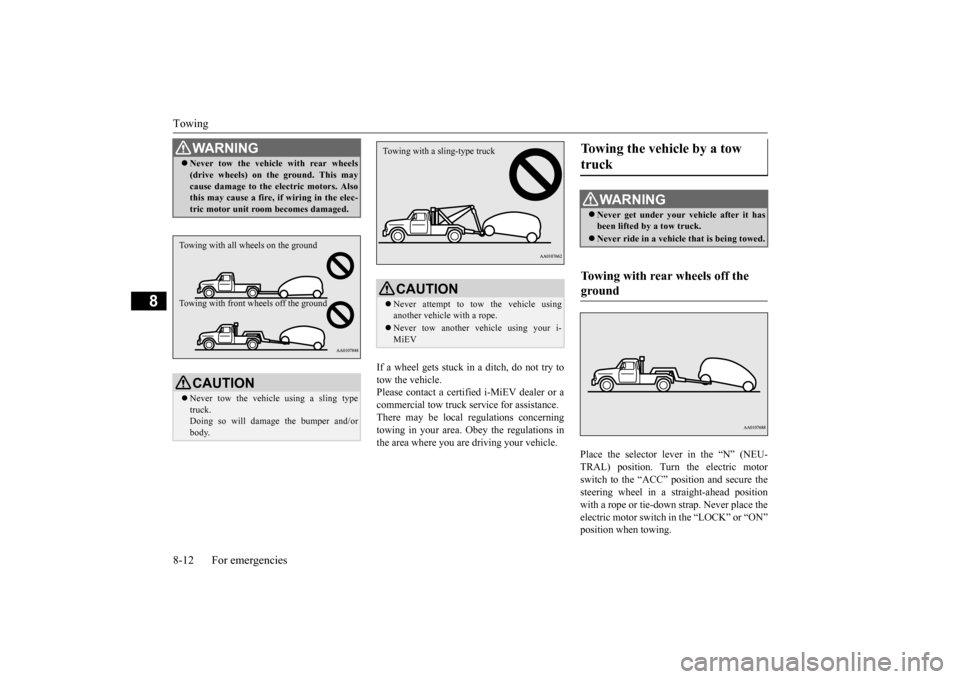
Towing 8-12 For emergencies
8
If a wheel gets stuck in
a ditch, do not try to
tow the vehicle. Please contact a certifie
d i-MiEV dealer or a
commercial tow truck service for assistance. There may be local re
gulations concerning
towing in your area. Obey the regulations inthe area where you are driving your vehicle.
Place the selector lever in the “N” (NEU- TRAL) position. Turn the electric motor switch to the “ACC” position and secure thesteering wheel in a st
raight-ahead position
with a rope or tie-down strap. Never place the electric motor switch in the “LOCK” or “ON”
WA R N I N G Never tow the vehicle with rear wheels (drive wheels) on th
e ground. This may
cause damage to the electric motors. Alsothis may cause a fire, if wiring in the elec- tric motor unit room becomes damaged.CAUTION Never tow the vehicl
e using a sling type
truck. Doing so will damage the bumper and/or body.Towing with all wheels on the ground Towing with front wheels off the ground
CAUTION Never attempt to tow the vehicle using another vehicle with a rope. Never tow another ve
hicle using your i-
MiEVTowing with a sling-type truck
Towing the vehicle by a tow truck
WA R N I N G Never get under your vehicle after it has been lifted by a tow truck. Never ride in a vehicl
e that is being towed.
Towing with rear wheels off the ground
BK0220401US.book 12 ページ 2015年6月3日 水曜日 午前7時42分
Page 245 of 296
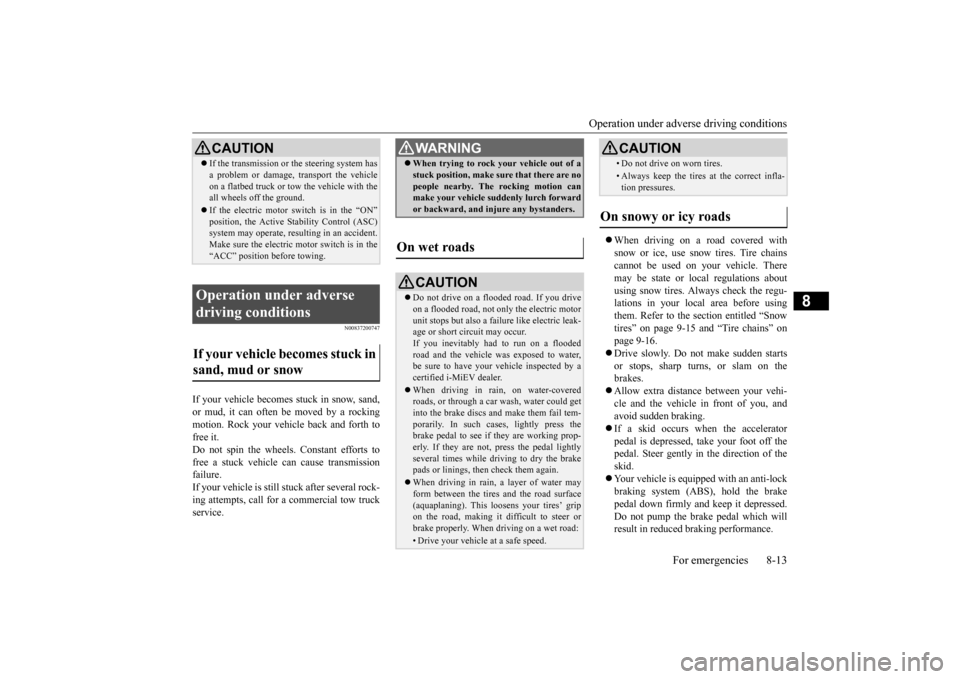
Operation under adverse driving conditions
For emergencies 8-13
8
N00837200747
If your vehicle becomes stuck in snow, sand, or mud, it can often be moved by a rocking motion. Rock your vehicle back and forth tofree it. Do not spin the wheels. Constant efforts to free a stuck vehicle can cause transmissionfailure. If your vehicle is still
stuck after several rock-
ing attempts, call for a commercial tow truckservice.
When driving on a road covered with snow or ice, use snow tires. Tire chains cannot be used on your vehicle. Theremay be state or local regulations about using snow tires. Always check the regu- lations in your local area before usingthem. Refer to the section entitled “Snow tires” on page 9-15 and “Tire chains” on page 9-16. Drive slowly. Do not make sudden starts or stops, sharp turns, or slam on the brakes. Allow extra distance between your vehi- cle and the vehicle in front of you, and avoid sudden braking. If a skid occurs when the accelerator pedal is depressed, take your foot off the pedal. Steer gently in the direction of theskid. Your vehicle is equippe
d with an anti-lock
braking system (ABS), hold the brakepedal down firmly and
keep it depressed.
Do not pump the brake pedal which will result in reduced braking performance.
CAUTION If the transmission or the steering system has a problem or damage,
transport the vehicle
on a flatbed truck or to
w the vehicle with the
all wheels off the ground. If the electric motor switch is in the “ON”
lting in an accident.
Make sure the electric motor switch is in the“ACC” position before towing.
Operation under adverse driving conditions If your vehicle becomes stuck in sand, mud or snow
WA R N I N G When trying to rock
your vehicle out of a
stuck position, make sure that there are nopeople nearby. The
rocking motion can
make your vehicle suddenly lurch forward or backward, and inju
re any bystanders.
On wet roads
CAUTIONDo not drive on a flooded road. If you drive on a flooded road, not only the electric motorunit stops but also a fail
ure like electric leak-
age or short circuit may occur. If you inevitably had to run on a floodedroad and the vehicle was exposed to water, be sure to have your vehicle inspected by a certified i-MiEV dealer. When driving in rain, on water-covered roads, or through a car wash, water could getinto the brake discs and make them fail tem- porarily. In such cases, lightly press the brake pedal to see if they are working prop-erly. If they are not, press the pedal lightlyseveral times while driv
ing to dry the brake
pads or linings, then check them again. When driving in rain, a layer of water may form between the tires and the road surface (aquaplaning). This l
oosens your tires’ grip
on the road, making it difficult to steer or brake properly. When driving on a wet road:• Drive your vehicle at a safe speed.
• Do not drive on worn tires.• Always keep the tires at the correct infla- tion pressures.
On snowy or icy roads
CAUTION
BK0220401US.book 13 ページ 2015年6月3日 水曜日 午前7時42分
Page 246 of 296
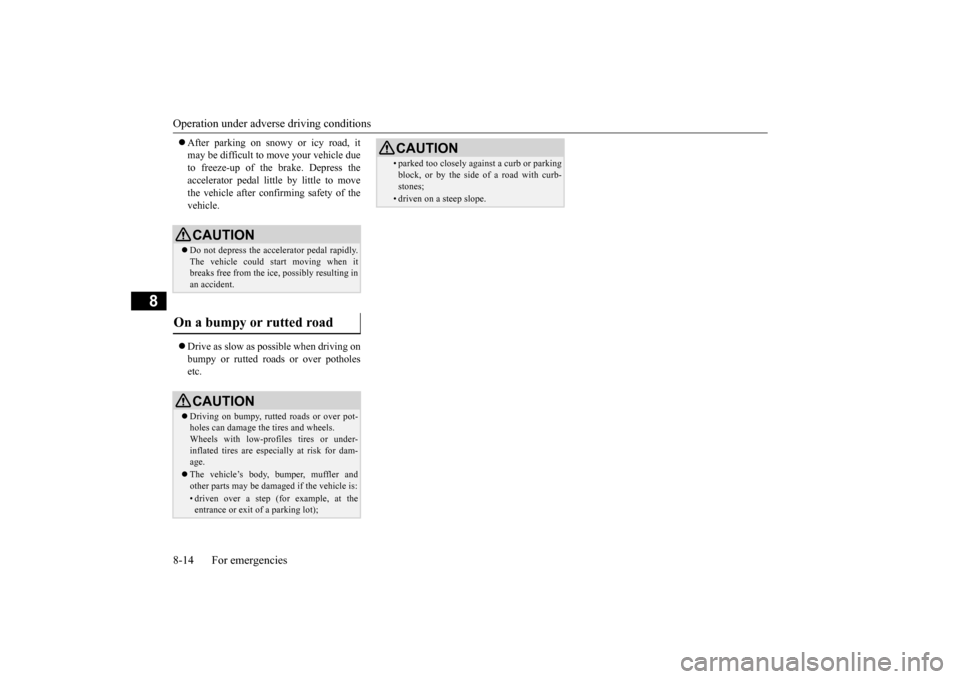
Operation under adverse driving conditions 8-14 For emergencies
8
After parking on snowy or icy road, it may be difficult to move your vehicle dueto freeze-up of the brake. Depress the accelerator pedal little by little to move the vehicle after confirming safety of thevehicle. Drive as slow as possible when driving on bumpy or rutted roads or over potholes etc.CAUTION Do not depress the acce
lerator pedal rapidly.
The vehicle could start moving when itbreaks free from the ic
e, possibly resulting in
an accident.
On a bumpy or rutted road
CAUTION Driving on bumpy, rutted roads or over pot- holes can damage the tires and wheels. Wheels with low-profiles tires or under-inflated tires are especi
ally at risk for dam-
age. The vehicle’s body, bumper, muffler and other parts may be dama
ged if the vehicle is:
• driven over a step (for example, at the entrance or exit of a parking lot);
• parked too closely against a curb or parkingblock, or by the side of a road with curb-stones;• driven on a steep slope.CAUTION
BK0220401US.book 14 ページ 2015年6月3日 水曜日 午前7時42分
Page 247 of 296
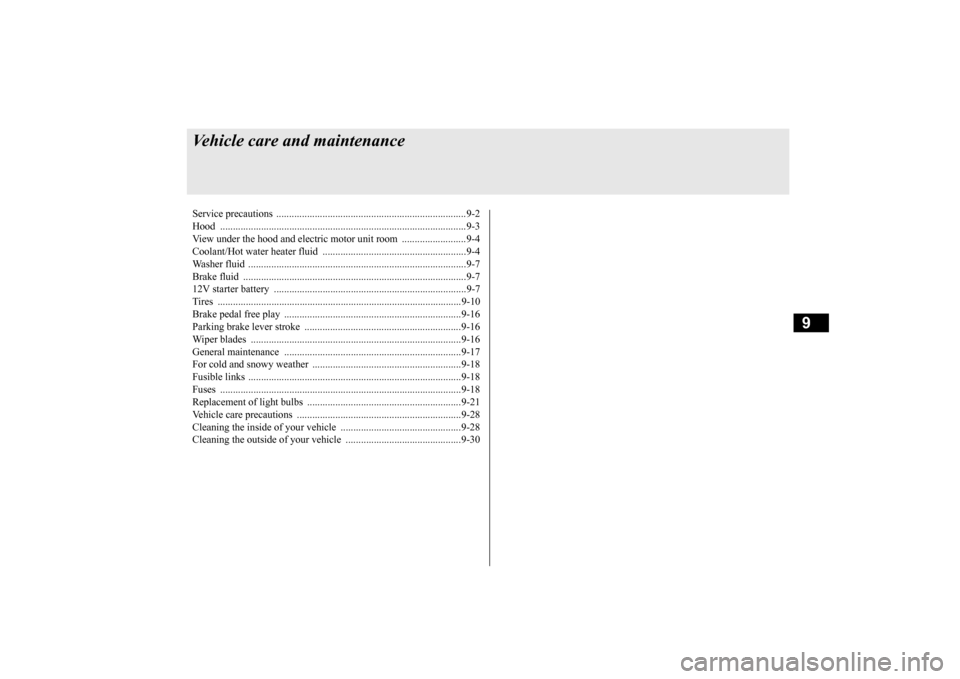
9
Vehicle care and maintenanceService precautions ..........................................................................9-2 Hood .............
............
...........
...........
...........
...........
...........
...........
.....9-3
View under the hood and electric motor unit room .........................9-4Coolant/Hot water heater fluid ........................................................9-4 Washer fluid .....................................................................................9-7 Brake fluid .......................................................................................9-712V starter battery ...........................................................................9-7 Tires ...............................................................................................9-10 Brake pedal free play .....................................................................9-16Parking brake lever stroke .............................................................9-16 Wiper blades ..................................................................................9-16 General maintenance .....................................................................9-17For cold and snowy weather ..........................................................9-18 Fusible links ...................................................................................9-18 Fuses ..............................................................................................9-18Replacement of light bulbs ............................................................9-21 Vehicle care precautions ................................................................9-28 Cleaning the inside of your vehicle .......
...........
...........
...........
.......9-28
Cleaning the outside of your vehicle .....
...........
...........
...........
.......9-30
BK0220401US.book 1 ページ 2015年6月3日 水曜日 午前7時42分
Page 248 of 296
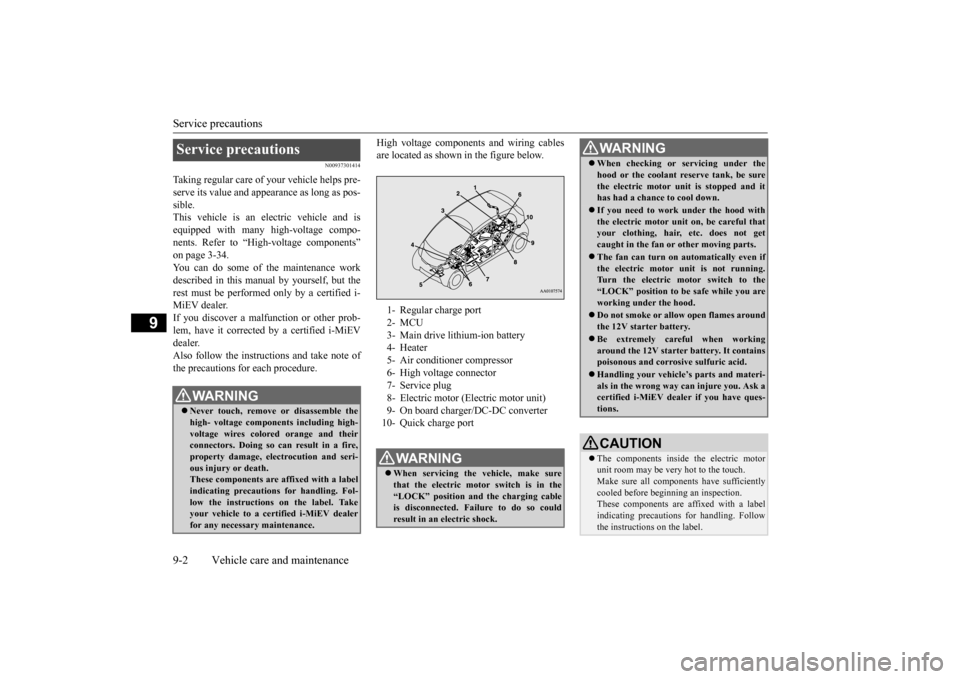
Service precautions 9-2 Vehicle care and maintenance
9
N00937301414
Taking regular care of your vehicle helps pre- serve its value and appe
arance as long as pos-
sible.This vehicle is an electric vehicle and is equipped with many high-voltage compo- nents. Refer to “High-voltage components”on page 3-34. You can do some of the maintenance work described in this manual by yourself, but the rest must be performed
only by a certified i-
MiEV dealer.If you discover a malfunction or other prob- lem, have it corrected by a certified i-MiEV dealer.Also follow the instru
ctions and take note of
the precautions for each procedure.
High voltage components and wiring cables are located as shown in the figure below.
Service precautions
WA R N I N G Never touch, remove or disassemble the high- voltage componen
ts including high-
voltage wires colore
d orange and their
connectors. Doing so can result in a fire, property damage, elec
trocution and seri-
ous injury or death. These components are affixed with a label indicating precautions for handling. Fol-low the instructions on the label. Take your vehicle to a cert
ified i-MiEV dealer
for any necessary maintenance.
1- Regular charge port 2- MCU 3- Main drive lithium-ion battery4- Heater 5- Air conditioner compressor 6- High voltage connector7- Service plug 8- Electric motor (Electric motor unit)10- Quick charge port
WA R N I N G When servicing the vehicle, make sure that the electric motor switch is in the“LOCK” position and
the charging cable
is disconnected. Failure to do so could result in an electric shock.
When checking or servicing under the hood or the coolant reserve tank, be surethe electric motor unit is stopped and ithas had a chance to cool down. If you need to work
under the hood with
the electric motor unit on, be careful that your clothing, hair, etc. does not get caught in the fan or other moving parts. The fan can turn on automatically even if the electric motor unit is not running.Turn the electric motor switch to the “LOCK” position to be
safe while you are
working under the hood. Do not smoke or allow open flames around the 12V starter battery. Be extremely careful when working around the 12V starter battery. It containspoisonous and corros
ive sulfuric acid.
Handling your vehicle’s parts and materi- als in the wrong way can injure you. Ask a certified i-MiEV dealer
if you have ques-
tions. CAUTION The components inside
the electric motor
unit room may be very
hot to the touch.
Make sure all components have sufficientlycooled before beginning an inspection. These components are affixed with a label indicating precautions
for handling. Follow
the instructions on the label.WA R N I N G
BK0220401US.book 2 ページ 2015年6月3日 水曜日 午前7時42分
Page 249 of 296
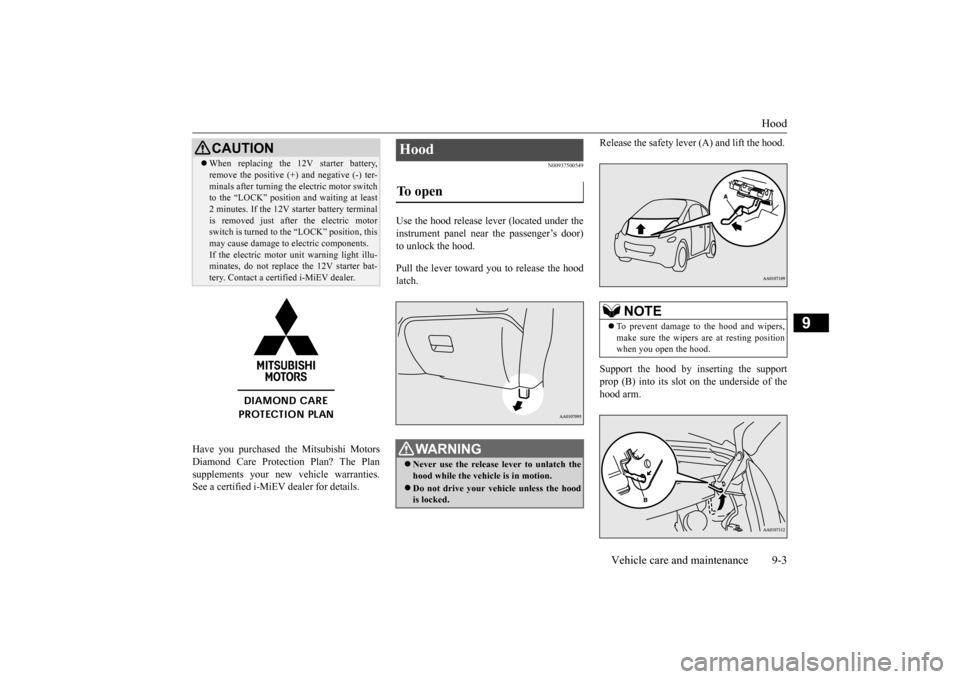
Hood
Vehicle care and maintenance 9-3
9
Have you purchased the Mitsubishi Motors Diamond Care Protec
tion Plan? The Plan
supplements your new
vehicle warranties.
See a certified i-MiEV dealer for details.
N00937500549
Use the hood release lever (located under the instrument panel near the passenger’s door) to unlock the hood. Pull the lever toward you to release the hood latch.
Release the safety leve
r (A) and lift the hood.
Support the hood by inserting the support prop (B) into its slot on the underside of the hood arm.
When replacing the
12V starter battery,
remove the positive (+
) and negative (-) ter-
minals after turning the electric motor switchto the “LOCK” position
and waiting at least
2 minutes. If the 12V st
arter battery terminal
is removed just after the electric motorswitch is turned to the “LOCK” position, this may cause damage to
electric components.
If the electric motor unit warning light illu-minates, do not replac
e the 12V starter bat-
tery. Contact a certified i-MiEV dealer.CAUTION
Hood To open
WA R N I N G Never use the release lever to unlatch the hood while the vehicle is in motion. Do not drive your vehicle unless the hood is locked.
NOTE
To prevent damage to the hood and wipers, make sure the wipers
are at resting position
when you open the hood.
BK0220401US.book 3 ページ 2015年6月3日 水曜日 午前7時42分
Page 250 of 296

View under the hood and
electric motor unit room
9-4 Vehicle care and maintenance
9
Make sure the hood is securely locked by softly lifting the centre of the hood. Slowly lower the hood about 12 inches (30 cm), then let it drop from its own weight.
N00937600700
N00937800539
CAUTION Always insert the support prop into the hole specially made for
it. Propping the hood at
any other place could
cause the prop to slip
out and lead to
an accident.
The hood prop can fall out if the hood is lifted by a strong wind.
To close
CAUTION Be careful not to trap your hands or fingers when closing the hood.
Make sure the hood is firmly closed before driving.If you drive without the hood completelyclosed, it could open up while driving.NOTE
If this does not close the hood properly, drop it again from a slightly higher position. Do not push down strongly on the hood. Depending on how strongly or where you push down, you could create a dent in the hood.
View under the hood and electric motor unit room
CAUTION
Under the hood
1- Windshield washer fluid reservoir 2- 12V starter battery 3- Hot water heater reservoir 4- Brake fluid reservoir5- Coolant reservoirCoolant/Hot water heater fluid To check the coolant level
WA R N I N G Before checking the
coolant level, make
sure the electric motor switch is in the“Lock” position to
avoid the risk of an
electrical shock that can result in serious injury or death.Electric motor unit room
BK0220401US.book 4 ページ 2015年6月3日 水曜日 午前7時42分